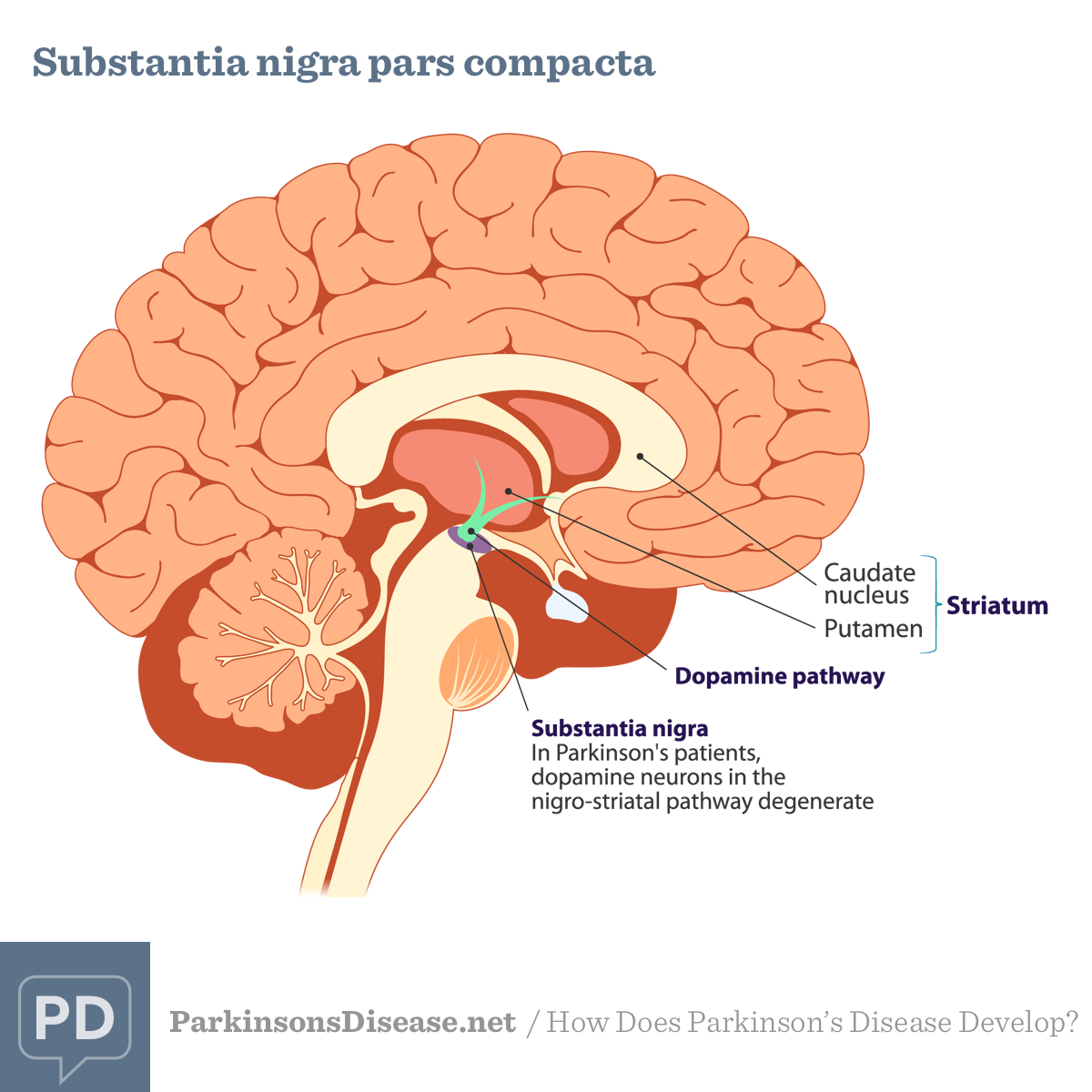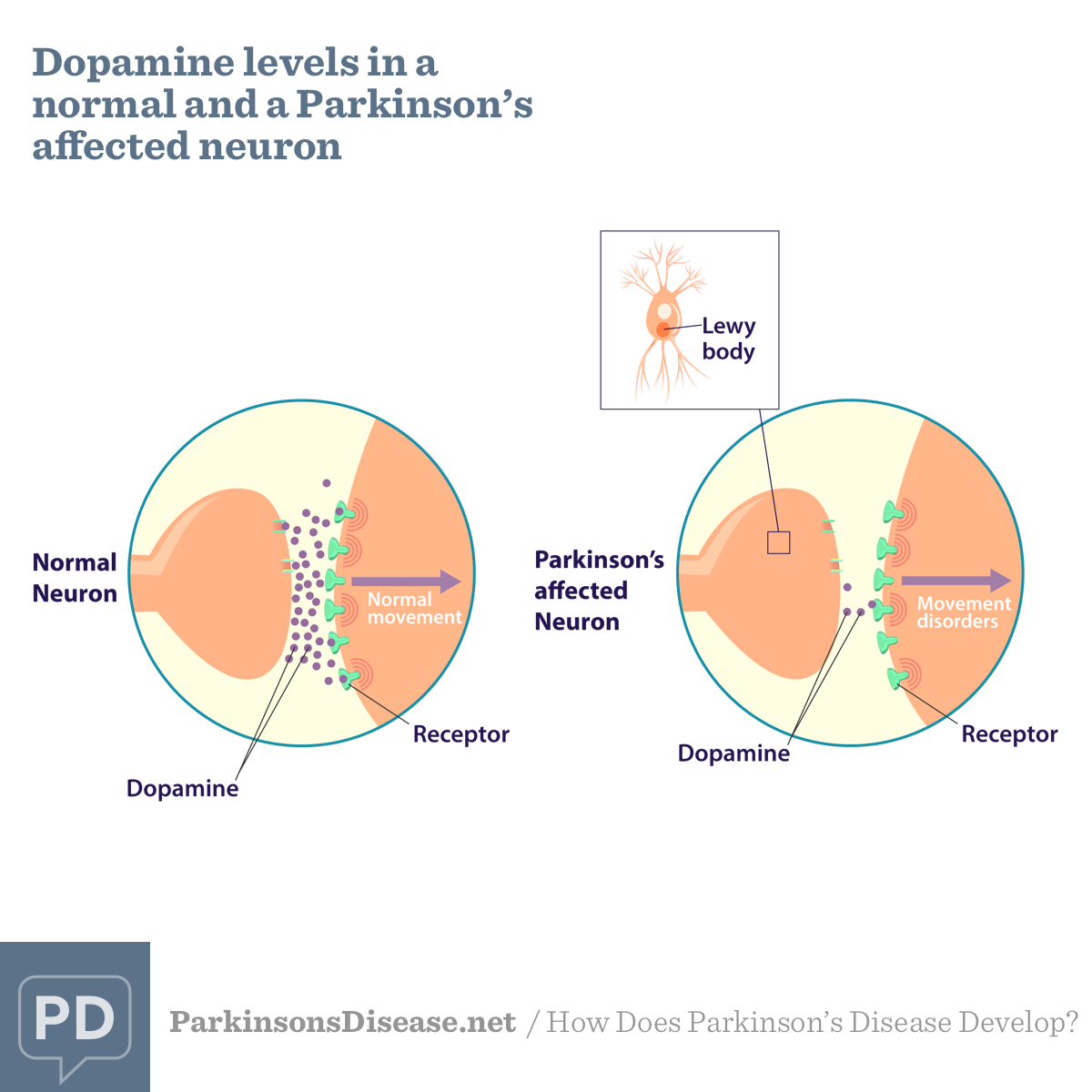How Does Parkinson's Disease Develop?
Reviewed by: HU Medical Review Board | Last updated: March 2022
Parkinson’s disease (PD) is a neurological (nervous system) disease that affects the way you move. It is a progressive disease, meaning that it steadily gets worse over time. There are treatments for PD, but it is not curable.1
The 4 most common motor symptoms of PD include:2
- Tremor at rest
- Rigidity (stiffness) of limbs, neck, or shoulders
- Impaired balance (postural instability)
- Slowness of movement or gradual loss of spontaneous movement (bradykinesia)
PD can also affect things other than your muscles. It can cause constipation, issues with urinating, depression, difficulty sleeping, and cognitive issues, among other symptoms. These are known as non-motor symptoms.2
What causes PD?
PD is caused by destruction of nerve cells (neurons) in an area of the brain called the substantia nigra. These neurons produce a chemical called dopamine that they use to communicate with other neurons in the brain.1
As these dopamine-producing neurons die, they are not replaced. This causes less and less dopamine to be released to send messages. Doctors do not yet know what causes dopamine-producing neurons to die in people with PD, though this is being studied.1
Dopamine released from these neurons in the substantia nigra is very important in an area of the brain called the basal ganglia. The basal ganglia helps regulate body movement. When the basal ganglia receives less dopamine, it inhibits or suppresses areas of the brain that promote body movement. This explains many of the motor symptoms in PD.1
Norepinephrine (NE) is another chemical produced by the brain. In PD, neurons that produce this chemical are also destroyed. NE is important in our sympathetic nervous system, which regulates our "fight or flight" response.1
This can cause some of the other non-motor symptoms of PD like constipation, difficulty urinating, and trouble regulating your heart rate or blood pressure.1
Figure 1. Substantia nigra pars compacta
Clinical stages
As PD progresses, you may experience different symptoms. PD is a bit different for everyone, but people often progress in a similar way. Doctors divided PD into 5 stages according to their symptoms:3
- Stage 1 – This is the earliest stage. You may experience mild tremors and mild difficulty walking just on 1 side of your body. Your loved ones may also notice that you do not make as many facial expressions. These symptoms do not interfere with daily life much.
- Stage 2 – Symptoms worsen in this stage. Tremors and difficulty moving now affect both sides of your body. Daily tasks are more difficult but still possible to complete on your own.
- Stage 3 – Balance and coordination are now affected. Falls are a big concern. You may need help with some tasks like dressing yourself and feeding yourself.
- Stage 4 – Tasks become very challenging. You might need a walker. You likely will struggle to live alone because you need help with most tasks.
- Stage 5 – This is the furthest stage. You may struggle to stand and walk even with help. You will most likely depend on a wheelchair or may be bed-bound. You also may develop new symptoms, such as cognitive impairment and hallucinations.
Figure 2. Comparing a normal neuron to a Parkinson's affected neuron
Braak staging
Braak staging is another way to understand how PD progresses based on brain pathology. However, this is a theory. There is evidence that this may be how PD works, but it is not confirmed.3
The idea behind this staging is that different PD symptoms occur when different areas of the brain are damaged. Each stage correlates to a different area of the brain. These look a bit different than the clinical stages:3,4
- Stage 1 – These researchers believe that the first areas affected by PD are the enteric nervous systemic and the olfactory bulb. The first refers to the nerves in your gut. The second is a brain area that is involved in smell. This could explain why those living with PD may struggle with constipation or changes in smell early on.
- Stage 2 – Nerves involved in the sympathetic nervous system are affected. This may explain difficulties urinating.
- Stage 3 – Areas of the brain involved in movement are beginning to be affected. This could explain tremors occurring only on 1 side of the body and bradykinesia.
- Stage 4 – Motor areas of the brain are further affected. Motor symptoms begin to worsen and affect both sides of the body.
- Stage 5 – Areas that help coordinate complicated actions are affected. People may now be confined to a wheelchair or bed. Basic actions require assistance.
- Stage 6 – Memory and mood areas are affected. This is the final stage, where people may experience dementia and cognitive impairment.
There has been some evidence to support these stages. However, not every person living with PD follows Braak staging patterns. Researchers are still studying this theory.
If you believe you or a loved one may have PD, or if you have questions about PD, talk to your doctor.

